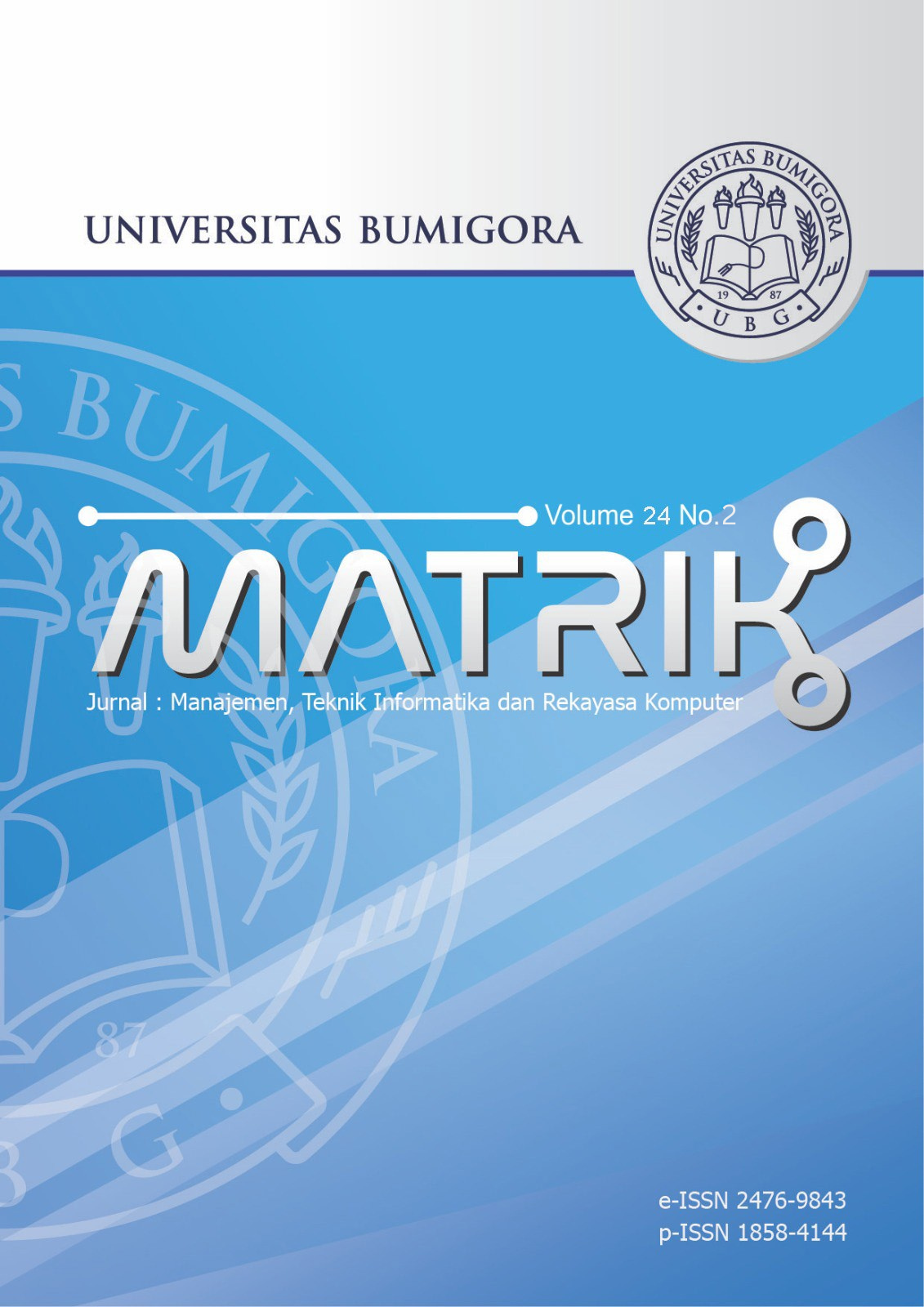Sentiment Study of ChatGPT on Twitter Data with Hybrid K-Means and LSTM
Analisis Sentimen Berdasarkan Hasil Klasterisasi K-Means pada Data Pengguna ChatGPT Menggunakan LSTM
DOI:
https://doi.org/10.30812/matrik.v24i2.4791Keywords:
Chat-Gpt, K-Means, Long Short-Term Memory, Sentiment Analysis, TF-IDF, Word2VecAbstract
The rapid evolution of artificial intelligence (AI) has transformed the way people interact with technology, with ChatGPT emerging as a standout innovation in natural language processing (NLP). While it offers immense benefits, such as improving productivity and accessibility, it has also sparked debates about trust, transparency, and user experience. This makes understanding public sentiment about ChatGPT both timely and essential.This study explores user sentiments by combining K-Means clustering and Long Short-Term Memory (LSTM) models for analysis. The research utilized a dataset from Kaggle, which underwent extensive preprocessing, including text cleaning, tokenization, and lemmatization. Key features were extracted using TF-IDF and Word2Vec techniques, while clustering was refined with the Elbow Method and Silhouette Score. The data was grouped into three clusters focusing on ChatGPT’s functions, its developers, and user activities. Sentiment analysis using LSTM achieved an impressive accuracy of 98% after five training cycles. The findings highlight that negative sentiments, particularly around technical challenges and transparency, dominate user feedback, signaling areas for improvement. While positive sentiments exist, they remain overshadowed by critical perspectives. This study underscores the importance of enhancing user trust and experience while ensuring ethical and transparent AI development. The insights provided aim to guide developers and policymakers in creating AI technologies that are more user-focused and socially responsible. Future research should include multilingual and cross-platform data to paint a more comprehensive picture.
Downloads
References
[2] F. M. Sinaga, S. J. Pipin, S. Winardi, K. M. Tarigan, and A. P. Brahmana, “Analyzing Sentiment with Self-Organizing Map and Long Short-Term Memory Algorithms,†Matrik: Jurnal Manajemen, Teknik Informatika dan Rekayasa Komputer, vol. 23, no. 1, 2024. DOI: 10.30812/matrik.v23i1.3332.
[3] Y. Akbar and T. Sugiharto, “Analisis Sentimen Pengguna Twitter di Indonesia Terhadap ChatGPT Menggunakan Algoritma C4.5 dan Naïve Bayes,†Jurnal Sains dan Teknologi, vol. 5, no. 1, pp. 115–122, 2023. DOI: 10.55338/saintek.v4i3.1368.
[4] D. Setiawan, D. Arsa, L. E. Fitri, and F. F. P. Zahardy, “Comparative Analysis of Clustering Approaches in Assessing ChatGPT User Behavior,†Cogito: Jurnal Penelitian dan Pengabdian Masyarakat, vol. 10, no. 2, pp. 366–379, 2024. DOI: 10.31154/cogito.v10i2.661.366-379.
[5] P. Yani and H. Baturohmah, “Analisis Sentimen Terhadap ChatGPT Plus Menggunakan Naïve Bayes di Twitter,†Sismatik: Jurnal Sistem Informasi dan Teknik Informatika, 2024. [Online]. Available: https://sismatik.nusaputra.ac.id/index.php/sismatik/article/view/210.
[6] I. Kurniasari, A. A. Alfin, and E. Widodo, “Implementasi Long Short-Term Memory (LSTM) dan Word Embedding Model pada Analisis Sentimen Layanan Uang Elektronik Ovo dan Link Aja,†Informasi: Jurnal Informatika dan Sistem Informasi, vol. 15, no. 2, 2023. DOI: 10.37424/informasi.v15i2.273.
[7] I. Dergaa, K. Chamari, P. Zmijewski, and H. B. Saad, “From human writing to artificial intelligence generated text: examining the prospects and potential threats of ChatGPT in academic writing,†Biology of Sport, 2023. DOI: 10.5114/biolsport.2023.125623.
[8] A. Nurkholis, D. Alita, and A. Munandar, “Comparison of Kernel Support Vector Machine Multi-Class in PPKM Sentiment Analysis on Twitter,†Jurnal RESTI (Rekayasa Sistem dan Teknologi Informasi), vol. 6, no. 2, pp. 227–233, 2022. DOI: 10.29207/resti.v6i2.3906.
[9] K. Maharana, S. Mondal, and B. Nemade, “A review: Data pre-processing and data augmentation techniques,†Global Transitions Proceedings, 2022. DOI: 10.1016/j.gltp.2022.04.020.
[10] R. R. Salam, M. F. Jamil, Y. Ibrahim, R. Rahmaddeni, S. Soni, and H. Herianto, “Sentiment Analysis of Cash Direct Assistance Distribution for Fuel Oil Using Support Vector Machine,†Jurnal Malcom, vol. 3, no. 1, 2023. DOI: 10.57152/malcom.v3i1.590.
[11] R. Sulthana, J. A. K., H. Harikrishnan, and V. Varadarajan, “Sentiment Analysis on Movie Reviews Dataset Using Support Vector Machines and Ensemble Learning,†International Journal of Information Technology and Web Engineering, vol. 17, no. 1, 2023. DOI: 10.4018/IJITWE.311428.
[12] F. Muftie, K. M. Yafi, and Q. M. Addina, “Perbandingan Performa Deteksi Cyberbullying dengan Transformer, Deep Learning, dan Machine Learning,†Jurnal Pendidikan Informatika dan Sains, vol. 13, no. 1, pp. 75–87, 2024. DOI: 10.31571/saintek.v13i1.4002.
[13] A. Sanmorino, Suryati, R. Gustrianysah, S. Puspasari, and N. Ariati, “Feature Extraction vs Fine-tuning for Cyber Intrusion
Detection Model,†Jurnal INFOTEL, vol. 16, no. 2, pp. 302–315, 2024. DOI: 10.20895/infotel.v16i2.996.
[14] A. Nurdin, B. A. S. Aji, A. Bustamin, and Z. Abidin, “Perbandingan Kinerja Word Embedding Word2Vec, GloVe, dan FastText pada Klasifikasi Teks,†Jurnal TEKNOKOMPAK, vol. 14, no. 2, pp. 74–79, 2020. DOI: 10.33365/jtk.v14i2.732.
[15] E. T. Wijaya, “Perancangan Information Retrieval (IR) Berbasis Term Frequency-Inverse Document Frequency (TF-IDF) untuk Peringkasan Teks Tugas Khusus Berbahasa Indonesia,†Jurnal Ilmiah Teknologi dan Informasi ASIA, vol. 7, no. 1, 2013. [Online]. Available: https://jurnal.stmikasia.ac.id/index.php/jitika/article/view/78.
[16] M. Guntara and N. Lutfi, “Cacah Klaster pada Klasterisasi dengan Algoritma K-Means Menggunakan Silhouette Coeficient
dan Elbow Method,†JuTI: Jurnal Teknologi Informasi, vol. 2, no. 1, Aug. 2023. DOI: 10.26798/juti.v2i1.944.
[17] A. T. Rahman, Wiranto, and R. Anggrainingsih, “Coal Trade Data Clusterung Using K-Means (Case Study PT. Global Bangkit Utama),†ITSMART: Jurnal Ilmiah Teknologi dan Informasi, vol. 6, no. 1, Jun. 2017. DOI: 10.20961/itsmart.v6i1.11296.
[18] M. Anggara, H. Sujiani, and H. Nasution, “Pemilihan Distance Measure Pada K-Means Clustering Untuk Pengelompokkan Member Di Alvaro Fitness,†Jurnal Teknik Informatika Universitas Tanjungpura (JUSTIN), 2023. [Online]. Available: https://jurnal.untan.ac.id/index.php/justin/article/view/13119.
[19] M. Robani and A. Widodo, “Algoritma K-Means Clustering Untuk Pengelompokan Ayat Al Quran Pada Terjemahan Bahasa Indonesia,†Jurnal Sistem Informasi Bisnis, vol. 6, no. 2, pp. 164–176, Dec. 2016. DOI: 10.21456/vol6iss2pp164- 176.
Downloads
Published
Issue
Section
How to Cite
Similar Articles
- Christofer Satria, Anthony Anggrawan, Tinjauan Kritis Jurnal Ilmiah: “The Influence of Transformational Leadership and Organizational Culture on Learning Organization: a Comparative Analysis of The it Sector†, MATRIK : Jurnal Manajemen, Teknik Informatika dan Rekayasa Komputer: Vol. 18 No. 1 (2018)
- Wikky Fawwaz Al Maki, Amien Jafar Makrufi, Support vector machine with a firefly optimization algorithm for classification of apple fruit disease , MATRIK : Jurnal Manajemen, Teknik Informatika dan Rekayasa Komputer: Vol. 22 No. 1 (2022)
- Didit Suhartono, Khairunnisak Nur Isnaini, Strategi Recovery Plan Teknologi Informasi di Perguruan Tinggi Menggunakan Framework NIST SP 800-34 , MATRIK : Jurnal Manajemen, Teknik Informatika dan Rekayasa Komputer: Vol. 20 No. 2 (2021)
- Husain Husain, I Putu Hariyadi, Kurniadin Abd Latif, Galih Tri Aditya, Implementation of Port Knocking with Telegram Notifications to Protect Against Scanner Vulnerabilities , MATRIK : Jurnal Manajemen, Teknik Informatika dan Rekayasa Komputer: Vol. 23 No. 1 (2023)
- Herlina Jayadianti, Budi Santosa, Judanti Cahyaning, Shoffan Saifullah, Rafal Drezewski, Essay auto-scoring using N-Gram and Jaro Winkler based Indonesian Typos , MATRIK : Jurnal Manajemen, Teknik Informatika dan Rekayasa Komputer: Vol. 22 No. 2 (2023)
- Debby Ummul Hidayah, Ika Romadoni Yunita, Gustin Setyaningsih, Evaluasi Website Kuliah Online STMIK Amikom Purwokerto Menggunakan Metode Heuristik (Studi Kasus Mata Kuliah Enterprise Resource Management) , MATRIK : Jurnal Manajemen, Teknik Informatika dan Rekayasa Komputer: Vol. 18 No. 2 (2019)
- Erna Daniati, Sucipto Sucipto, Anita Sari Wardani, Akmal Hisyam Pradhana, Usability Test on the System Determination Decision Support ReleaseProduct Towards Contribution Level Decision Maker , MATRIK : Jurnal Manajemen, Teknik Informatika dan Rekayasa Komputer: Vol. 24 No. 3 (2025)
- Nurahman Nurahman, Agung Purwanto, Sigit Mulyanto, Klasterisasi Sekolah Menggunakan Algoritma K-Means berdasarkan Fasilitas, Pendidik, dan Tenaga Pendidik , MATRIK : Jurnal Manajemen, Teknik Informatika dan Rekayasa Komputer: Vol. 21 No. 2 (2022)
- Christofer Satria, Anthony Anggrawan, Aplikasi K-Means berbasis Web untuk Klasifikasi Kelas Unggulan , MATRIK : Jurnal Manajemen, Teknik Informatika dan Rekayasa Komputer: Vol. 21 No. 1 (2021)
- Dyah Susilowati, Hairani Hairani, Indah Puji Lestari, Khairan Marzuki, Lalu Zazuli Azhar Mardedi, Segmentasi Lokasi Promosi Penerimaan Mahasiswa Baru Menggunakan Metode RFM dan K-Means Clustering , MATRIK : Jurnal Manajemen, Teknik Informatika dan Rekayasa Komputer: Vol. 21 No. 2 (2022)
You may also start an advanced similarity search for this article.


.png)












